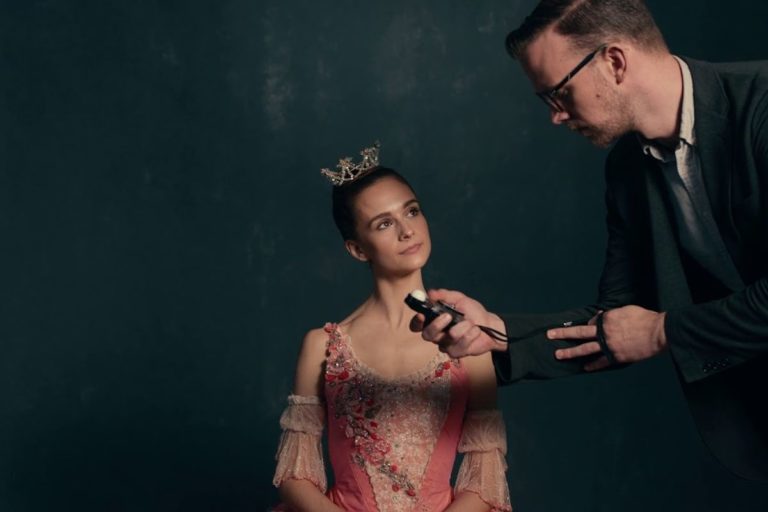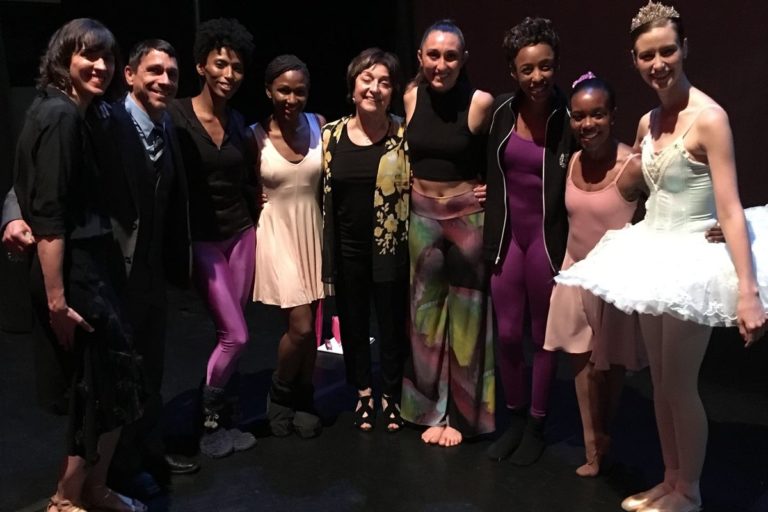
Whether you work in concert dance or in the commercial world, the question of the moment seems to be, “What is contemporary?” The answer is as varied as the practitioners one asks. Here, eight teachers who experiment with modern dance vocabulary, new and old, share their philosophies, the way their classes developed and what it takes to be a versatile dancer.
Christian Burns
Improvisation
San Francisco Conservatory of Dance
For Christian Burns, choreography and improvisation are inextricably linked. “There are different ways people approach improvisation, and for many it’s a personal practice that is never seen,” he says, making it clear this is not the case with him. “The primary end point I’m interested in is performance.” The co-founder of the San Francisco–based company, The Foundry, has performed with Alonzo King LINES Ballet and has had experience with both contact and Forsythe-style improvisation. “My classes are almost as much composition classes as they are experiential,” he says. “It’s very important to be choreographically literate, even if you do not want to be a choreographer.”
In class, he strives for a balance between improvised movement studies with strict parameters and more open structures. To help students understand the intention of an exercise, he moves with them and talks through what he’s doing. “I’m always in the middle of my classes, practicing what I’m teaching,” he says. “I think more is transmitted by my being there in the space with them.” He sometimes uses a stopwatch to keep his dancers working in the moment—something so vital to successful improvisation, yet so easy to dismiss. “Whether we do 10 seconds or a few minutes, regardless of what they’re doing, when the time is done, I call it and we break.” —Andrea Marks
Chanel DaSilva
Modern Dance Sampler
Trey McIntyre Project
Chanel DaSilva’s widely varied modern dance training—she’s done Graham, Horton, Limón, Cunningham and Taylor, to name a few—has provided her with a surefire way to hold her students’ attention: Just keep changing things up. She’ll wake up her students’ feet with Horton exercises, mobilize their cores with Graham contractions and sprinkle in some Limón, since it “feels really good” on her own body and incorporates well.
As a dancer for Trey McIntyre Project, she teaches master classes in which participants range from junior high students to those studying dance at the college level. Her class always finishes with TMP repertory as the final combination.
She’s also a stickler for musicality. The Juilliard-trained DaSilva grew up attending Creative Outlet Dance Theatre in Brooklyn, NY, where she took an array of classes—hip hop, jazz, West African—all of which required strict attention to rhythm. This has aligned nicely with her professional career. “Trey’s work is often super-musical, so I’m going to stress what he stresses,” she says. She guarantees her students that it will come in handy. “As a professional dancer, it’s something people just assume you have.” —Rachel Rizzuto
Jodi Melnick
Postmodern Release Technique
Barnard College; New York University
“Many of my new students think I’m totally wacko,” says Jodi Melnick. “’Why is she talking about her liver and kidneys in dance class?'” Instead of focusing on the external lines and shapes, Melnick teaches from the inside out, making sense of how the organs, tissues, muscles and bones inform a dancer’s technique. Her cerebral thirst for modern dance came after college, but that doesn’t mean her students should expect philosophy without physicality. Melnick grew up studying everything from gymnastics to tap, earned a BFA from SUNY Purchase and danced with Twyla Tharp, 1991–94. Her diverse movement history is what truly informs her class.
Drawing on her scattered studies, Melnick has created a secure class structure. “I’m not teaching a codified technique, but I’ve really codified class for myself: I was doing jazzy Twyla, I worked in release technique, I can’t imagine warming up without Cunningham exercises and I’m deeply interested in yoga and tai chi. Why not embrace it all?” she asks. “That’s an intelligent dancing body. One that takes in as much information as it can and uses what works.” —Kristin Schwab
Ariel Freedman
Gaga
Jacob’s Pillow; Peridance Capezio Center
As an undergrad at Juilliard, Ariel Freedman had the Type A personality that many dancers possess. “I was a very anxious student—always stressed and wanting to get things exactly right,” she says. It was her first Gaga class, the sensory-focused improvisation technique created by Ohad Naharin, that brought her some relief. “When you’re training very seriously in codified dance forms, it’s easy to forget to let go and remember why you’re dancing,” she says. “By the end of class I felt I could tackle anything. I reconnected to my original passion, which was to move.”
A year after graduation, Freedman relocated to Israel to join Naharin’s Batsheva Dance Company and, after five years with the company, returned to New York to pass along the technique. “Gaga can make you feel uncomfortable, naked and overwhelmed. But I hope to show dancers that those feelings show progression,” she says. “Part of my job is to help them learn how to undo some of their training. They’re not throwing it away, but keeping it at their fingertips. Then dance doesn’t become imitation, but about trusting your instincts and training.” —KS
Bebe Miller
Contemporary
Ohio State University
Though as a student Bebe Miller struggled with the finer points of technique, she has become a strong proponent for traditional modern dance class structure. “My teacher was Tharp-oriented and very articulate and specific, but I was not a detailed technician,” Miller says. But she stuck with it and eventually discovered an interest in body mechanics. “I became fascinated with how I was doing things and what was actually happening in the body. I drank the Kool-Aid of technique,” she says.
“I learned to teach a conventional technique class: a warm-up and across the floor and then the ‘big dance,'” says Miller, who has also studied Nikolais, Alexander and Klein techniques and qigong, a Chinese meditation method. She contrasts her approach to the more free-form, experimental trends of today: “Dancers who are doing everything on the floor, everything in silence with their eyes closed,” she says.
Miller has been teaching certain exercises for more than 20 years, about as long as she’s been directing her internationally renowned Bebe Miller Company. If something works—for her students or choreographic process—she sticks to it, like a qigong exercise she uses during her warm-up. “I do that just as I learned it,” she says. “That’s one of the things that I don’t mess around with. It’s just like magic.” —AM
Nicole Wolcott
Punk Rock Modern
Dance New Amsterdam; Hunter College
Nicole Wolcott’s mission is to spread what she calls the JOD—Joy of Dance—because she finds that students who take themselves too seriously can easily become disheartened about their training. Ultimately though, the co-founder of Keigwin + Company seeks to foster the artist as a whole.
Her first job was dancing with Gus Giordano in Chicago. She studied briefly at Lou Conte Dance Studio and went to Columbia College Chicago, where she met Risa Steinberg. “I was so inspired by how she taught Limón,” says Wolcott.
“The paradigm of modern dance is that dancers are collaborators. They need to be able to generate movement and make smart choices. Technique is only one tool in your belt,” she says. “That’s hard for traditionally trained people to be comfortable with. It makes them itch. But for me, letting go of it a little bit was absolutely freeing.” She says that trusting her technical base and relinquishing the idea of right versus wrong allowed her finally to take control of how she wanted to dance. —KS
Teena Marie Custer
Modern Rooted in Hip Hop
Slippery Rock University
No matter the course title, some element of street dance is always evident in Teena Marie Custer’s classes at Slippery Rock University, where she teaches hip hop and contemporary. She describes her modern class as “Doris Humphrey and [b-boy legend] Ken Swift shaken up in a bottle.” “If I’m teaching them about Loie Fuller,” she says, “we’ll add in some house technique. With Graham, I’ll add in some breaking, because there’s so much floor work in Graham.”
Growing up as a street dancer in Pittsburgh, Custer wasn’t exposed to formal dance training until college. After she earned her degree, she spent a year performing with Attack Theatre and Dance Alloy. Then, as an MFA candidate at Ohio State University, she was introduced to Cunningham and dance theater.
Strengthening and conditioning take up a significant portion of her 90-minute class: Pilates and exercises like burpees are all included. “I call them Mack Trucks by the end of the semester,” she says, laughing, as she refers to how strong the students get. But there’s also a noticeable change in their confidence—the community-building element of hip-hop culture inevitably creeps in. —RR
Chris Aiken
Contact Improvisation
Smith College
Chris Aiken’s class flips the stereotype about contact improvisation on its head: Rather than the I-lift-you, you-lift-me approach, he teaches people about their bodies and the physics of dancing, equally interweaving movement and theory. Understanding issues of alignment and one’s center allows his students to achieve structural support that’s also mobile.
One building block of his class is “tensegrity”—balancing tension with compression, like a successfully constructed tent (strongest when the tension is stretched across its entire surface). Tensegrity, as Aiken explains, allows someone, regardless of size, to maximize strength and flexibility—a necessary tenet of successful weight-sharing.
Awareness is equally important: Aiken will ask his students to attune themselves to vision, sense of space, balance and, eventually, the space between each other. “Can you touch somebody in a way that makes no physical demands on them?” is one of his favorite questions to ask his students, most of whom are entirely new to the practice.
After listening to Aiken talk so intelligently about contact improvisation, it is surprising to learn that he didn’t take a dance class until age 20. In Boston, he went to Dance New England’s freestyle jams (“Like a nightclub,” he says, “without the alcohol and smoke”) and saw people doing what he later learned was contact improvisation. This started his intensive exploration of the form, studying with gurus Nancy Stark Smith, Steve Paxton and Daniel Lepkoff. After nearly 30 years, Aiken feels confident in what he imparts to his students. “I know how to make the work safe and physical and sensitive and creative,” he says. “And I need to continually reinvigorate my students’ sense of imagination—that’s my job, as their teacher.” —RR



